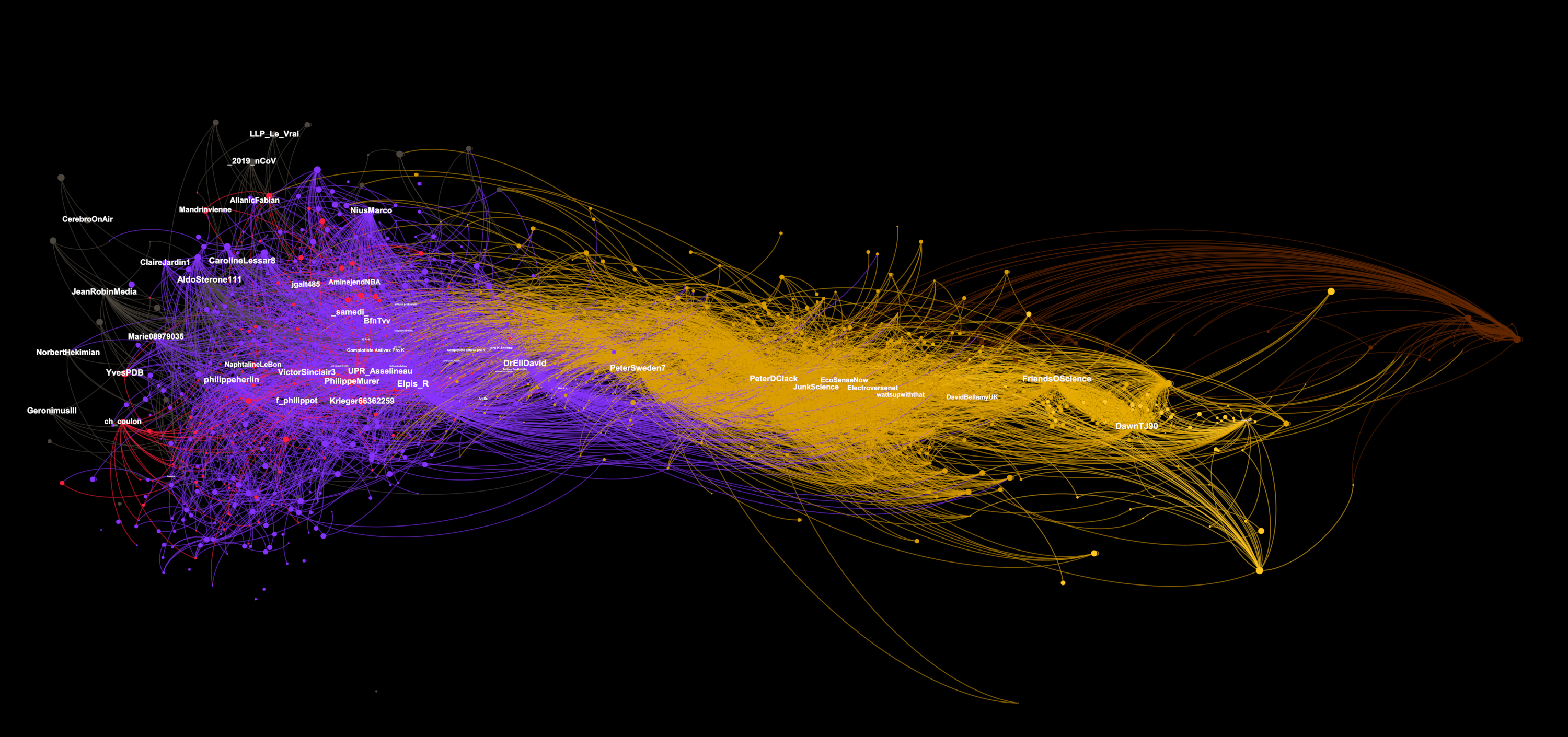Download the study
PDF version (online on 05-23-2023)
Citation : David Chavalarias, Paul Bouchaud, Victor Chomel, Maziyar Panahi. The new fronts of denialism and climate skepticism: Two years of Twitter exchanges under the macroscope. 2023. ⟨hal-04103183v2⟩
Beyond “fact-checking”, this study aims at a better understanding of the circulation of different narratives related to climate change and in particular those related to disinformation. Here are the main results and conclusions:
At the global level
- The global climate change debate on Twitter is highly bipolarized with about 30% climate denialists among Twitter accounts that address climate issues over the period 2019-2022,
- The COVID-19 pandemic has distracted public opinion from climate change issues for several months,
- Experts from the IPCC and pro-climate communities focus their messages on their areas of expertise while the denialist community presents inauthentic forms of expertise: a core group of accounts speaks on a multitude of topics, concentrate presumed expertise, and fabricate the majority of the denialists narratives in circulation. Some of the denialists’ favorite topics reveal an active agenda setting uncorrelated with current events.
- The proportion of Twitter accounts with inauthentic behaviors in the exchanges has increased significantly since 2019 on a global scale, pointing to possible astroturfing operations. However, exchanges on climate change issues are largely organized around human-to-human interactions.
- The denialist community has an over-representation of accounts with inauthentic behaviors of +71% compared to pro-climate communities, with 6% of accounts “probably bot”. This phenomenon is particularly pronounced in the United States where there has been a steady increase since February 2022 in the over-representation of denialist accounts with inauthentic behavior (likely bots), which has exceeded 400% in 2023.
- Since spring 2022 Twitter has become an active place of conversion to climate skepticism while losing at the same time its status as a globalized space for the expression of opinions on climate change.
- Pro-climate accounts flee from Elon Musk’s Twitter. After Elon Musk’s takeover of the platform in Oct. 2022, about one third of core pro-climate accounts left the network while the activity of these communities was halves.
- The proportion of climate skeptics has been steadily increasing on Twitter over the past two years. This increase accelerated sharply following Musk’s takeover, with the proportion of climate skeptics reaching 50% by March 2023.
France : a prototypical case (extended version only)
- A large French denialist community was structured in the summer of 2022 on Twitter. A remarkable fact since the French twittersphere had been relatively unaffected by climate skepticism until 2022,
- A higher proportion of accounts “likely bot”. The proportion of inauthentic accounts in the French denialist community is 2.8 times higher than in the French IPCC community. The proportion of accounts suspended by Twitter is ten times higher.
- The denialist community produces or relays 3.5 times more toxic messages than the IPCC community.
- Inauthenthic Opportunistic behavior. The main influencer of the French denialist community is a newcomer to the cause after a period spent campaigning against government measures against the COVID-19 pandemic. The transition was made at the time of the invasion of Ukraine and he relayed pro-Putin propaganda for a time. The account was dormant since 2012 and woke up in 2021.
- Weird political signature. Apart from some accounts involved in the informational sphere of Reconquête! (French far-right), the major part of the denialist community is not composed of political activists from traditional parties (LFI, PS, EELV, Renaissance, LR or RN).
- An “anti-system” trend. The denialist community on Twitter is mostly composed of accounts that have participated in numerous anti-system protest campaigns during the pandemic. Moreover, out of 10 000 accounts, nearly 6000 have relayed Kremlin propaganda about the war in Ukraine.
- Likely foreign interference. The issue of the fight against global warming and the characteristics of denialist activists make this societal issue a particularly favorable terrain for foreign interference operations of the subversion type.
- Impact on climate scientists. A causality analysis shows that in the medium term, the publication of IPCC leads the debate on Twitter around climate issues. Twitter discourse from the denialist and technosolutionist communities likely hinders the dissemination of scientific knowledge and IPCC findings by negatively affecting the online activity of climate science and climate change scientists.
Evolution of interactions around the theme of climate change on Twitter
Worldwide
Video illustration of the study by Chavalarias, Bouchaud, Chomel, Panahi (2023).
WHAT DO WE SEE? Nodes correspond to Twitter accounts. Links are retweet links between accounts. They are directional and have the color of the sender. The denialist community is in brown, on the bottom.
In all, over 200,000 accounts are represented in this video. An account only appears at a given time if it has been active and will be active again. When a node is not active or not interacting with other accounts, it appears isolated and moves to the periphery.
WHY DOES IT MOVE? Accounts move as connections are made and broken over time, and it’s possible for an account to be temporarily attracted to a community that doesn’t reflect its views if members of that community start retweeting it, even if it doesn’t interact with its members.
HOW ARE LABELS CHOSEN? Only the most active or most followed accounts in this theme have been labelled after a manual check of their publications. When an account does not appear as a public figure and is not anonymous, the account name has been replaced by elements of its Twitter profile to provide context (like MAGA for example for US MAGA supporters).
WHAT DO WE HEAR? the sonification is based on the debates within French political communities on the subject of climate change. Data come from the CNRS/ISC-PIF platform Politoscope over the same period. A sound instrument/texture is assigned to each political community, and its daily level of activity gives a score.There is one note per day and per community, and 150 days per minute, which gives the soundtrack.
In France
On this video we can clearly see the intensification of exchanges during the COPs, their attenuation during the Christmas holidays and the overactivity of the denialist community since the summer of 2022.
This video, also presented in the exhibition “Foules” at the Cité des Science et de l’Industrie Museum in Paris, reconstructs the exchanges about climate change on Twitter, observed in the Climatoscope over several months worldwide.
ADDITIONAL CREDITS
Video and sound: David Chavalarias, CNRS/CAMS, ISC-PIF (see other videos)
Data: ISC-PIF Climatoscope & Politoscope projects, Multivac platform, Maziyar Panahi.
Dynamic graph visualization software: Gephi.org.
Dynamic spatialization algorithm: ForceAtlas2; Jacomy, M., Venturini, T., Heymann, S., Bastian, M., 2014. ForceAtlas2, a Continuous Graph Layout Algorithm for Handy Network Visualization Designed for the Gephi Software. PLOS ONE 9, e98679. https://doi.org/10.1371/journal.pone.0098679

